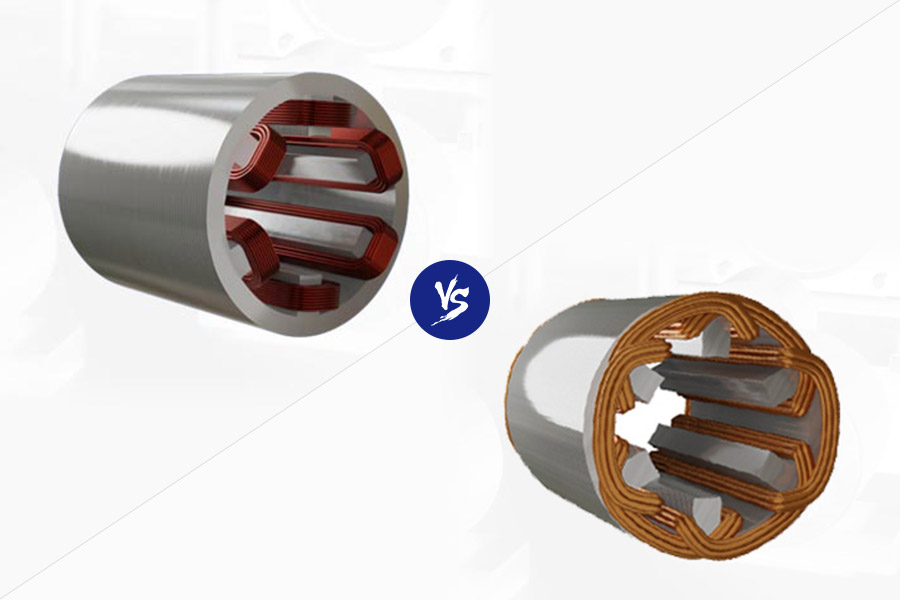In electric motor design, the choice of winding configuration affects performance, efficiency, and longevity. There are two popular varieties of windings: concentrated and distributed. Each has unique benefits and optimal applications. This article compares both to help engineers optimize motor performance.
What Are Distributed and Concentrated Windings?
Concentrated Winding:
In concentrated winding, the coils are wound in a way that all of the coils corresponding to a particular phase are placed together in a small, compact region of the stator. Essentially, each coil occupies a limited number of slots within the stator, leading to higher coil density in those slots. The coils are typically wound in a single-layer fashion.
Distributed Winding:
Conversely, with distributed winding, the coils are dispersed among multiple stator slots. This method involves distributing the coil windings in multiple layers over a greater area. Each coil is divided and wound over multiple stator slots, ensuring an even distribution of the winding throughout the stator.
Key Factors Influencing Winding Choice
The choice between concentrated and distributed winding is influenced by various factors, including motor application, required torque and efficiency, and design complexity. Each winding method offers unique benefits, making them suitable for different scenarios.
1. Efficiency
The effectiveness of the winding type is one of the primary considerations. The winding configuration can directly affect the motor’s overall energy consumption and performance.
Concentrated Winding:
Concentrated windings have fewer turns per coil, resulting in a higher peak current in the winding. This can lead to higher power losses in certain applications, especially when motors operate at high speeds. The concentrated winding also results in a less uniform magnetic field, which can reduce motor efficiency in some designs.
Distributed Winding:
Distributed windings, with their coils spread over several stator slots, generally result in a more uniform magnetic field. The motor’s overall efficiency is increased and harmonic distortion is decreased as a result. The uniform distribution of coils leads to a more stable operation, reducing eddy current losses and increasing energy efficiency.
2. Torque Ripple
Torque ripple, which refers to the fluctuations in the motor’s torque output during rotation, is another key performance indicator.
Concentrated Winding:
One of the drawbacks of concentrated winding is its higher torque ripple. Since the coils are placed in a limited number of slots, they tend to create a non-uniform magnetic field, which results in uneven torque production. This could lead to vibrations and noise during operation, which may be undesirable in precision applications like robotics or electric vehicles.
Distributed Winding:
Distributed windings offer a more balanced distribution of magnetic fields, leading to smoother torque production. The spread of coils across different slots minimizes torque ripple, ensuring a quieter and more stable operation. This makes distributed windings ideal for applications where smoothness and precision are crucial, such as in industrial machinery or high-performance electric vehicles.
3. Size and Weight
Motor size and weight are important considerations for many applications, particularly in industries where space is at a premium or weight limitations exist.
Concentrated Winding:
Due to the higher coil density within a smaller area, concentrated winding tends to be more compact. This configuration is beneficial for applications requiring a compact and lightweight design. For example, small motors used in power tools or drones may benefit from the use of concentrated windings.
Distributed Winding:
Distributed windings typically require more space because the coils are spread across multiple slots. This means that motors using distributed winding tend to be larger and heavier compared to those with concentrated windings. However, this increase in size can often be offset by the enhanced efficiency and reduced torque ripple in high-performance applications.
4. Manufacturing Complexity and Cost
The complexity of manufacturing plays a crucial role in the selection of winding configuration, particularly when considering production costs.
Concentrated Winding:
Concentrated windings are easier and faster to manufacture compared to distributed windings. The simpler design results in lower production costs, making it an attractive option for manufacturers looking to produce motors in large quantities. Additionally, in high-volume production settings, the simplicity of design and assembly is advantageous.
Distributed Winding:
Distributed windings require a more complex design and manufacturing process. The winding itself involves more steps, such as the precise placement of coils in various stator slots and the use of multiple layers. While this increases manufacturing time and costs, the resulting motor performance may justify the additional investment in certain high-performance applications.
5. Cooling Performance
Efficient cooling is crucial for maintaining optimal motor performance, especially in high-power applications. The arrangement of windings affects the cooling mechanism in motors.
Concentrated Winding:
With concentrated windings, the windings are located in fewer slots, meaning the cooling is less evenly distributed. Hot spots in the engine could arise from this, particularly at higher power levels. However, with careful design, concentrated winding can still offer adequate cooling for lower-power applications.
Distributed Winding:
Distributed windings allow for better airflow between coils, helping to improve cooling efficiency. This is especially crucial for applications requiring continuous operation or high power output. The even distribution of windings ensures that heat is dissipated more evenly across the motor, leading to longer motor life and improved performance.
Concentrated and Distributed Winding Applications
Concentrated Winding:
Ideal for motors requiring compact size and higher torque at lower speeds. Applications include small appliances, power tools, drones, and certain automotive systems.
Distributed Winding:
Best suited for high-performance motors where efficiency, smooth operation, and torque stability are essential. Typical applications include electric vehicles, industrial machines, robotics, and renewable energy systems.
Comparison Table: Concentrated Winding vs. Distributed Winding
| Feature | Concentrated Winding | Distributed Winding |
| Efficiency | Generally lower efficiency, higher losses at high speeds | Higher efficiency, more stable performance |
| Torque Ripple | Higher torque ripple, leading to vibrations | Reduced torque ripple, smoother operation |
| Motor Size and Weight | More compact, lighter | Larger, heavier |
| Manufacturing Complexity | Simpler, lower manufacturing cost | More complex, higher manufacturing cost |
| Cooling Performance | Less effective cooling, potential hot spots | Better cooling, more even heat distribution |
| Applications | Small motors, power tools, drones | Electric vehicles, industrial machines, robotics |
| Use in High-Power Systems | Less suitable for high-power systems | Ideal for high-power applications |
Conclusion
Choosing between concentrated and distributed windings depends on application and performance goals. Concentrated windings are cost-effective and compact, ideal for smaller motors, while distributed windings offer superior performance, efficiency, and smooth operation for high-power applications. Engineers must balance efficiency, torque ripple, size, and cost to select the best winding type for their motor design.



